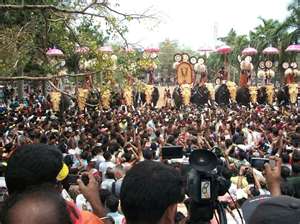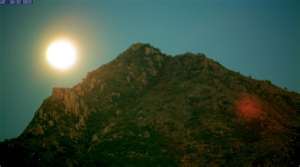The constellation of Delta Leonis is known as Pubba or Pooram, one of the 27 constellations which tenant the Ecliptic. There are more than one million temples in Kerala. Several temple festivals occur on the Lunar Asterism of their inception.
The famous Trichur Pooram occurs on the Pubba day of Mesha or Delta Leonis in the sidereal month of Aries. More than 500,000 people witness this Festival of all Festivals. It is of 36 hours durations and it is one of the most beautiful sights in the world, according to UNESCO.
More than 50 caparisoned elephants pass through the center of Trichur Town , the Lord Shiva Temple.
Earlier the Pooram was at Arattupuzha and it so happened that the Chief of Peruvanam Gramam denied entry to the temples of Trichur. This enraged the Naduvazhis of Trichur and the then ruler, Shaktan Tampuran, integrated all the ten temples around the central Lord Shiva Temple, Vadakkunnathan ( situated at a hillock ) and created this Grand Pooram. Tampuran created two Groups, the Eastern and the Western. The Eastern group was called as Paramekkavu, consisting in addition to Paramekkavu temple, Karamukku, Chembukavu, Choorakottukavu and Panamukkamppilly. The Western group was Thiruvambady consisting of Kanimangalam, Laloor, Ayyanthole, Nethilakkavu and the Thiruvambady temple.
This Pooram is centered around the Lord Shiva temple at the Center, as all the ten deities pay obeisance to the Shiva, the central presiding deity. Shaktan Tampuran chalked out the program and the main events of this Glorious Festival.
In Kudamattom, that is changing of colored umbrellas this year, techonology was used. LED umbrellas were used and it was a glorious sight at seven pm. 15 caparisoned elephants of the Eastern Group faced the 15 elephants of the Western Group.
The Ten Participating Temples
Along with the main Paramekkavu Temple
&
Thiruvambady Temple in Trichur
Kanimangalam Sastha Temple at Kanimangalam, Pookkattikkara
Karamukku Baghavathy Temple at Karamukku near Chiyyaram,
Choorakkottukavu Bagavathy Temple at Choorakkattukara,
Laloor Baghavathy Temple at Laloor,
Sree Karthyayani Temple at Ayyanthole,
Nethilakkavu Bagavathy Temple at Neithilakkavu near Kuttoor,
Chembukkavu Bagavathy Temple at Chembukkavu and
Panamukkumpally Sastha Temple at Panamukkampilly near East Fort Thrissur











